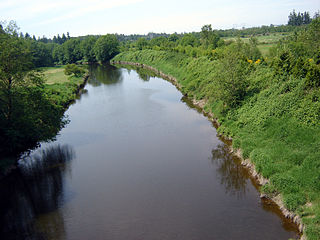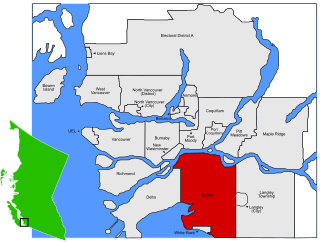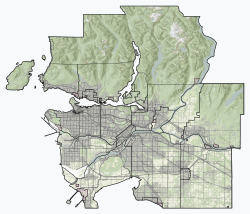
Surrey is a city in British Columbia, Canada. It is located south of the Fraser River on the Canada–United States border. It is a member municipality of the Metro Vancouver regional district and metropolitan area. Mainly a suburban city, Surrey is the province's second-largest by population after Vancouver and the third-largest by area after Abbotsford and Prince George. Seven neighbourhoods in Surrey are designated town centres: Cloverdale, Fleetwood, Guildford, Newton, South Surrey, and City Centre encompassed by Whalley.

White Rock is a city in British Columbia, Canada, and a member municipality of the Metro Vancouver Regional District. It borders Semiahmoo Bay to the south and is surrounded on three sides by Surrey. To the southeast across a footbridge lies the Semiahmoo First Nation, which is within the borders of Surrey. Semiahmoo Bay and the Southern Gulf Islands in the Strait of Georgia are also to the south.

The City of Langley, commonly referred to as Langley City, or just Langley, is a municipality in the Metro Vancouver Regional District in British Columbia, Canada. It lies directly east of Surrey, adjacent to the Cloverdale area, and is surrounded elsewhere by the Township of Langley, bordered by its neighbourhoods of Willowbrook to the north, Murrayville to the east, and Brookswood and Fern Ridge to the south.

Boundary Bay is a shallow bay situated on the Pacific coast of North America on the Canada–United States border between the Canadian province of British Columbia and the U.S. state of Washington.

The Peace Arch Border Crossing is the common name for the Blaine–Douglas crossing which connects the cities of Blaine, Washington and Surrey, British Columbia on the Canada–United States border. I-5 on the American side joins BC Highway 99 on the Canadian side. Being the most direct route between the major cities of Seattle, Washington and Vancouver, British Columbia, the crossing is the third-busiest on the border with up to 4,800 cars a day. Trucks and other commercial vehicles are prohibited from this location and use the Pacific Highway Border Crossing, which is 1.6 kilometres (1 mi) eastward.

Semiahmoo Shopping Centre is an indoor shopping mall on the Semiahmoo peninsula in Surrey, British Columbia, Canada. Opened in 1980, the shopping centre is named after the nearby Semiahmoo Bay and is currently anchored by Save-On-Foods and Winners.

South Surrey is a community within the City of Surrey, British Columbia, located on the Semiahmoo peninsula in the southern portion of the City of Surrey, sharing a border with the City of White Rock. Neighbourhoods of South Surrey include Crescent Beach, Crescent Heights, Elgin, Chantrell Creek, Morgan Creek, Grandview Heights, Hazelmere, Ocean Park, and Sunnyside. Most of South Surrey lies in White Rock's population centre.

The Nicomekl River springs from the ground in Langley, British Columbia and travels west through the city to Surrey's Crescent Beach, where it empties into Mud Bay, the northernmost section of the Boundary Bay of the Strait of Georgia. It has a total length of 34 km, with a drainage area of 149 km2.

Ocean Park is a neighbourhood of South Surrey, a region of Surrey, British Columbia.

Semiahmoo Bay is the southeastern section of Boundary Bay on the Pacific coast of North America. The bay is named for the Semiahmoo First Nation, who originally occupied the area. The Semiahmoo Peninsula borders the bay and was home to cannery operations. It is now home to the Semiahmoo Golf Resort.

Semiahmoo Spit is a spit that protrudes from the westernmost expanse of shore on Semiahmoo Peninsula between Semiahmoo Bay and Drayton Harbor off the coast of Blaine in Whatcom County, Washington state. The spit is home to Semiahmoo Park

The Campbell River passes through Surrey and Langley, British Columbia, Canada, entering Semiahmoo Bay at the Semiahmoo Indian Reserve, which lies between the City of White Rock and Peace Arch Park on the international boundary.
The Semiahmoo are a Coast Salish indigenous people whose homeland is in the Lower Mainland region of southwestern British Columbia, Canada.

Sunnyside is a neighbourhood of South Surrey, which in turn is a region of Surrey, British Columbia, Canada.
The Kennedy Trail was the first settler built trail in the Lower Mainland of British Columbia, Canada. James Kennedy first proposed "a trail from some point opposite New Westminster, across to some other point near to Semiahmoo Bay" in a letter written to Governor James Douglas in June 1860. He said "it would be the cause of speedy settlement of the land". In January 1861 Kennedy signed a contract to build the trail with the Chief Commissioner of Lands and Works, Colonel Richard Clement Moody.
The Snokomish were a Halkomelem-speaking Coast Salish people whose territory was primarily located across the Boundary Bay area. The Snokomish were also known as the Derby people, as their territory included a portion of the Fraser River, near Derby, British Columbia.
Marine Drive is the name for three major roadways in Greater Vancouver, British Columbia, Canada. The roads are known for running parallel to major bodies of water, with some sections being a major arterial road, while other serve local traffic. Marine Way is the name applied to a section of Marine Drive that was bypassed in the early 1980s.



















